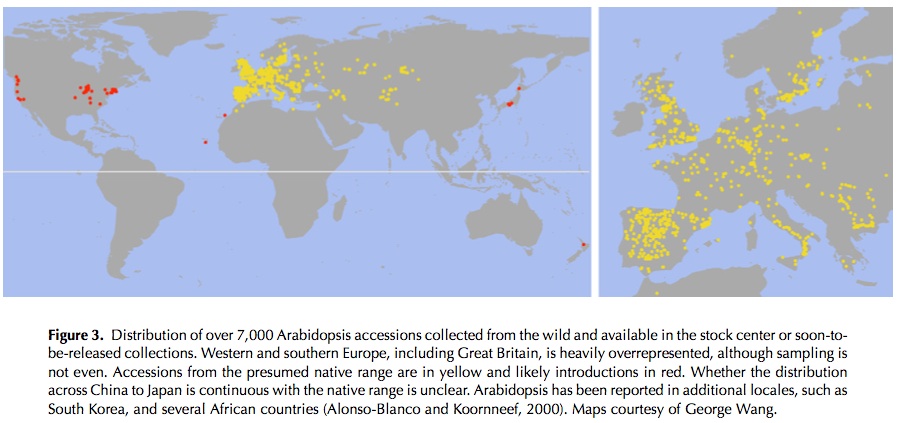Introduction to Arabidopsis thaliana
General Background:
Arabidopsis thaliana belongs to the family Brassicaceae, which includes agriculturally important crops such as cabbage, cauliflower, brussel sprouts, bok choy, radish and chinese cabbage. The genus Arabidopsis contains about ten species that are native to Eurasia, North Africa and North America, including Arabidopsis lyrata and Arabidopsis halleri, the closest relatives of A. thaliana (Koch et al 2001).
A. thaliana is native to Eurasia (Fig.1 Yellow Dots), however has been introduced in North Africa and North America as well (Fig.1 Red Dots). It is commonly found in disturbed areas (such as agricultural fields, roads, and railways), rocky habitats, and forest openings (T. Mitchell-Olds and M. Clauss, unpublished).
Map of 7,000 known Arabidopsis populations (taken from Weigel (2012))
More information about Arabidopsis (note click on the green text to link to the different sources):
- Arabidopsis Growth Timeline Slideshow. The slideshow features images and description of Arabidopsis thaliana growth week-by-week from germination of a seed all the way through the plant maturation (senescence). The slideshow loads as a new page, however does not start automatically. Use the controls on the bottom left of the page to play the slideshow and/or to navigate manually through the pages.
- Excerpt from Seed to Seed. A short introduction to Arabidopsis thaliana as a model system from the book Seed to Seed: The Secret Life of Plants by Nicholas Harberd
- Excerpt_MitchellOlds_Schmitt_2006. This is the Introduction to 2006 Nature paper “Genetic mechanisms and evolutionary significance of natural variation in Arabidopsis” by Thomas Mitchell-Olds and Johanna Schmitt.
- Video: Introduction to Arabidopsis. This video, narrated by David Lally from the PREP U (Partnership for Research in Plants) program at Virginia Tech, introduces Arabidopsis thaliana as a model plant species.
Bibliography:
- Koch, M et al. (2001) Molecular systematics of the Cruciferae: evidence from coding plastidic matK and nuclear CHS sequences. Am. J. Bot. 88: 534–544
- Mitchell-Olds, T (2001) Arabidopsis thaliana and its wild relatives: a model system for ecology and evolution. Trends in Ecology and Evolution 16(12): 693-700
- Weigel, D (2012) Natural variation in Arabidopsis: From molecular genetics to ecological genetics. Plant Physiology 158: 2-22

